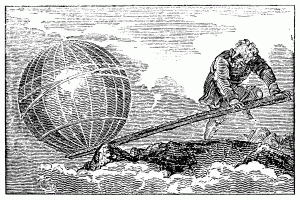 sphaira (Gk)
sphaira (Gk)- ball, Homer, Odyssey 6.100.
- any globe (Parmenides 8.43), thus, sphere, as a geometrical figure, etc., esp. the terrestrial globe, earth (Strabo 2.3.1).
- hollow sphere or globe: in ancient physics, from the time of Anaximander, of the spheres believed to revolve round the earth carrying the heavenly bodies, and according to the Pythagoreans arranged after the intervals of the musical scale (Cicero, Republic 6.18; Aristotle, Metaphysics 1073b18); thus, sphaira aplanês, the sphere of the fixed stars, and hai planômenai sphaira, a planetary sphere (Plutarch 2.1028a).

Athanasius Kircher’s reconstruction of the sphere of Archimedes, imitating the motion of the planets with the aid of magnets.
From Magnes, Sive de Arte Magnetica (1643 ed.) 305.
sphairopoiia (Gk)
- artificial sphere (hence the thaumaturgic globe-makers of Alexandria of the third century BC, the first of whom was apocryphally Archimedes; see Evans and Harley & Woodward);
- making of the heavenly spheres
cf. sphairopoièsis, “invented” by Peter Sloterdijk to describe the generation of the characteristic shape or “thought-figure” of globalisation in its metaphysical (à la the Greek philosophers), territorial (à la the Iberian voyagers) and terrestrial (à la transcendental capitalism) forms (see “Geometry in the Colossal: The Project of Metaphysical Globalization“).
Archimedes’ hefting of the idea of the globe to the status of ruling metaphor in Greek science realized Plato’s metaphysical (or, as Sloterdijk might say, cosmogonic) theory of the cosmos in the Timaeus—and, to a lesser degree, Aristotle’s On the Heavens, which, alas, superceded Plato’s through the undue influence of Ptolemy’s cosmology (the Almagest). And he found us a place to stand—which was, of course, no place at all (he was playing Atlas, as all modern scientists do) . . .

Archimedes: “Give me a place to stand on, and I will move the Earth”
(δῶς μοι πᾶ στῶ καὶ τὰν γᾶν κινάσω).
From Pappus of Alexandria, Synagoge 7.
cf. Einstein: “it is the theory that decides what we can observe” (Timothy Ferris, The Red Limit: The Search for the Edge of the Universe [Harper Collins, 1983]) and “μοχλός (lever) and μηχανή (machine)” and “‘About the Word Design’ by Vilém Flusser.”